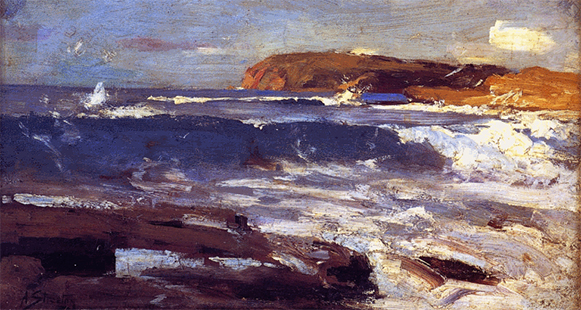 Celebrating Arthur Streeton’s contribution to the formation of an Australian identity, a new exhibition at the heritage South Australian property, Carrick Hill, Arthur Streeton: Blue and Gold goes on display from 25 October 2017.
Celebrating Arthur Streeton’s contribution to the formation of an Australian identity, a new exhibition at the heritage South Australian property, Carrick Hill, Arthur Streeton: Blue and Gold goes on display from 25 October 2017.
Taking its name from Streeton’s statement: “Nature’s scheme of colour in Australia is gold and blue…” the exhibition will highlight his depiction of land and seascapes, both in Australia and abroad.
“The exhibition will comprise around twenty works drawn from public and private collections taking inspiration from the three paintings by Streeton included in the Hayward Bequest here at Carrick Hill,” said Anna Jug, Carrick Hill’s Associate Curator.
“The show celebrates Streeton’s contribution to the formation of an Australian identity demonstrating Streeton’s treatment of bush, sea, river and mountains in oil paintings, as well as in a number of his sketch studies.”
Sir Arthur Ernest Streeton was born at Mount Duneed, near Geelong, in 1867. Academic life did not appeal, so a young Streeton left school in Melbourne at the age of thirteen and took up several different jobs. At nineteen, his creativity and aptitude for sketching led him to being apprenticed as a lithographer to a company in Collins Street.
Streeton held little interest in art theory throughout his life: as a young man he took night classes in drawing at the National Gallery School of Design, but otherwise was self-taught, experimenting with technique. It was the friendship he struck up with Tom Roberts, an artist returned from study at the Royal Academy, which had a profound influence on Streeton.
He was invited to an artist camp away from the city in Box Hill, where artists were experimenting with the French technique en plein air. Impressionism had already reached its pinnacle in Europe, but to Arthur Streeton and a stream of young Australian artists, it was ground-breaking, allowing them to see and paint the Australian landscape in a new way.
Anna Jug says Streeton’s painting, An Impression from the Deep, from the collection of the Art Gallery of South Australia, is an example of this. “The sound of the crashing waves and taste of the sea spray is almost as tangible to us as it was to Streeton as he painted it,” she said. “His quick brush strokes and bold colours used during those early days painting at Box Hill and Heidelberg would linger in work throughout his life.”
Streeton forged a name for himself in Australia and in 1898 he travelled to London where he spent the next twenty years, intermittently returning to Australia for inspiration. Streeton’s name has become synonymous with grand scale works, such as The Victoria Tower, Westminster in which he pays homage to the British Masters.
The city of Venice proved a fabulous model for the artist when he honeymooned there in 1908. Carrick Hill’s own Venice, Bride of the Sea is a product of this Italian sojourn and was exhibited in Melbourne along with others in a series called Arthur Streeton’s Venice, which was hugely successful for the artist. His Venetian pictures still rank amongst Streeton’s most iconic works.
Streeton and his family relocated to Australia permanently in the 1920s with the Artist spending the last eighteen years of his life in Victoria, painting grand landscape works such as The Land of the Golden Fleece.
“Carrick Hill’s The Blue Mountains, a work that is a culmination of a life’s devotion to landscape painting, was painted in those later years,” said Jug. “There is a sense of drama created by the shadows in contrast to the light splashes over the rocky crop dominating the foreground. Most importantly, this picture proudly bears the colour scheme of the Australian landscape, blue and gold.”
Arthur Streeton: Blue and Gold
Carrick Hill, 46 Carrick Hill Drive, Springfield
Exhibition: 25 October 2017 – 25 February 2018
Admission fees apply
For more information, visit: www.carrickhill.sa.gov.au for details.
Image: Arthur Streeton, An Impression from the Deep, 1889. Collection of the Art Gallery of South Australia.
